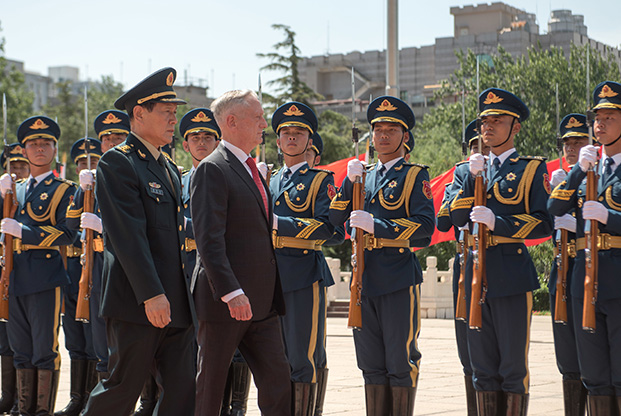
Defense Secretary Jim Mattis meets with Chinese Defense Minister Gen. Wei Fenghe at the People's Liberation Army's Bayi Building in Beijing, China, on June 28. DoD photo by Army Sgt. Amber Smith.
A new RAND Corporation report has uncovered a potential pattern behind how China decides whether or not to play copycat with foreign militaries’ aerospace power capabilities and concepts.
The report, “Defeat, Not Merely Compete: China’s View of Its Military Aerospace Goals and Requirements in Relation to the United States,” found that the People’s Liberation Army (or PLA) seems to mimic other militaries when it’s able to track down “low-cost hardware, organization, or operational concepts” that it can tweak to meet its operational needs, according to a report summary.
When foreign solutions can’t be reconstituted to solve military aerospace challenges, the summary explains, “the PLA either innovates its own solution” or opts against trying to copy “the foreign capability,” even though it still tracks and studies it.
And when the PLA doesn’t seem to be trying to compete with other militaries, it’s because it can either carry out the mission at hand without that particular capability or tackle the current challenge another way, according to the summary.
In the report, Scott Harold, its author and the associate director of RAND’s Center for Asia Pacific Policy, identifies a few ways in which knowledge of Chinese military aerospace power development and investment can help the Air Force:
- Better understanding the PLA’s strengths and weaknesses within the realm of military aerospace can help the service focus on places where it can better exploit its vulnerabilities, while steering clear of areas where China’s capacity is stronger.
- The Air Force, along with the rest of the military and US “national security establishment,” can use analyses of China’s aerospace development “to identify possible or probable vectors along which the PLA is likely to target US interests in any armed clash.” This information can also be leveraged “to avoid certain types of military-to-military contact that might unintentionally help the PLA further advance its capabilities,” he wrote.
- A better comprehension of when such development mimics US or international military aerospace power can help the US improve the targeting of its “denial and deception efforts.”
The report recommends the Air Force make sense of China’s advances “in specific domains related to ISR, strategic and tactical lift, and strike platforms and assets, as well as power projection in and through space and against space-based satellite architectures,” and keep an eye on “a range of other PLA investments and changes,” including “doctrine, organization, training, manpower, logistics, procurement, and facilities,” the summary says.
The report also found that China’s primary motivation for beefing up its military aerospace power is so that it can be ready “to deter and, if necessary, defeat the United States in a high-end clash.” Harold explains that the PLA aims to use competition with the US military to achieve political goals set forth by the Chinese Communist Party, which it brainstormed based on its “threat perceptions and policy ambitions.”
“It is important to recognize that many of the PLA’s efforts in the military aerospace sector focus on fielding specific capabilities in sufficient quantities to deter the United States from entering a conflict; the PLA would vastly prefer this over victory through combat,” Harold writes.